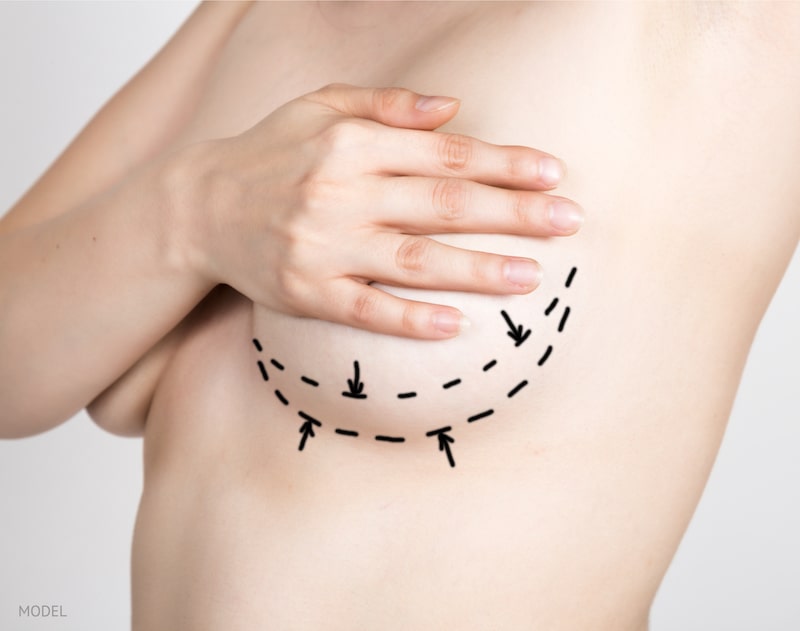Home|Blog | What Incisions Can Be Used During a Breast Lift? Will Any Incision Work?
What Incisions Can Be Used During a Breast Lift? Will Any Incision Work?
4 Minute Read:
With time, many women’s breasts begin to stretch, deflate, and droop, wreaking aesthetic havoc on their once perky and fuller appearance. An effective way to combat sagging breasts is with breast lift surgery, which removes excess skin and tightens the surrounding tissue to create a more youthful breast contour. Often, this is performed in conjunction with breast augmentation.

What Incision Techniques Are Used During a Breast Lift?
A breast lift can be performed using various incision patterns and techniques, depending on the level of breast ptosis, cup size, degree of loss of elasticity, surgeon preference, and other factors.
Anchor Breast Lift/Inverted-T
The anchor-shaped breast lift, also known as the inverted-T, is the gold standard of breast lift surgery and, commonly, the best choice even though it results in the longest incisions.
The anchor lift involves an incision around the areola, which then extends vertically down to the crease at the bottom of the breast (called the inframammary fold) and then horizontally along this crease. This technique offers the maximum degree of correction and control in three dimensions allowing for the best results possible. The reward for this precision is a far better shape—which IS the ultimate goal.
This approach is the best for addressing moderate to advanced ptosis and is unnecessary for more minor situations. For milder drooping, other techniques can give good results with far shorter, less conspicuous scars.
There are some women who absolutely do not want the lengthier incisions necessary for this technique, despite their extensive drooping, and will only opt for short scars. If these shorter scar options were to be used in such situations, the results from surgery would be severely compromised—abnormal and distorted shapes, significant asymmetries, bizarre scar configurations and widened scars.
For Dr. Turkeltaub’s patients, if they still insist on the inappropriate shorter scar techniques for their breast drooping, he explains that they should then strongly consider not having the surgery. In these situations, he also tells his patients that he will not perform their surgery because he will not do a procedure knowing that it is the wrong choice and the ultimate outcome will be poor.
Crescent Breast Lift
The crescent breast lift involves just one small incision that runs along the upper half of the areola. It’s only suitable for women with the most minimal degree of sagging and works best to slightly elevate the areola. Only a small amount of skin can be removed; otherwise, significant distortions, including with the areola, will occur.
Periareolar Breast Lift
Also known as the donut, Benelli, or circumareolar lift, this technique uses an incision around the areola only. Although it does not require incisions (and therefore scars) on the lower pole of the breast, there often will be a thick, irregular, and widened scar around the areola. With time, the areola frequently stretches out, resulting in a poor outcome. In addition, this approach creates a flat appearance where a more conical shape is the desired one.
The donut technique offers limited access to the breast tissue. Like the crescent technique, the procedure works for women with very mild sagging who only want to benefit from a more subtle lifting. When employed for those with more extensive drooping, the results are frequently inferior, yielding strange un-breast-like shapes.
Vertical Breast Lift “Lollipop”
The lollipop lift allows for better contouring than the donut lift, especially for women with somewhat mild sagging breasts. This technique involves an incision around the areola, which then extends down to the breast crease, resulting in a lollipop shape.
While it can give an aesthetically pleasing lift with shorter incision lines than the anchor lift, this method doesn’t address all excess skin, especially where it is most common and most necessary—the vertical dimension.
How to Determine the Right Breast Lift For You?
The best way to determine which breast lift technique will work best for you is to schedule a consultation with an experienced board-certified plastic surgeon like Dr. Turkeltaub, who has extensive expertise in the procedure. He will evaluate your concerns by taking the following into account:
- Your breast anatomy
- Degree of breast sagging
- Amount of tissue to be removed
- Your specific wishes and desired outcome
Based on the evaluation, Dr. Turkeltaub will recommend the best technique that addresses your specific surgical needs and goals.
Interested in Learning More?
If you are considering having surgery to lift your breasts, schedule your personalized consultation with Dr. Turkeltaub to educate yourself on the options available to you.
Contact us today at 480-451-3000 to get started.
